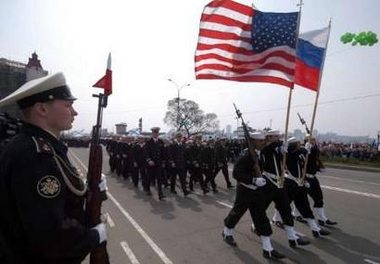By Joseph Cerami.

Actually, the United States and Russia have cooperated, in very recent history, in the removal and destruction of weapons of mass destruction. Under what are known as Nunn-Lugar programs, the US has worked closely with Russia, and other countries, in removing weapons of mass destruction with remarkable efficiency and effectiveness. Syria will be different, but the US has much recent experience to build on.
The efforts by Senators Sam Nunn (Democrat of Georgia) and Richard Lugar (Republican of Indiana) in US-Russian Cooperative Threat Reduction Programs were key to the effectiveness of the Counterproliferation Policy Initiative that was launched during the first Clinton Administration.
Government policymakers, national security experts, scientists and engineers were among the first to seize the opportunity for forming new relationships among the United States, Russia, and the former Soviet republics (FSR) following the fall of the Berlin Wall in 1989. Initially, President George H.W. Bush’s notion of a new world order (see George Bush and Brent Scowcroft, A World Transformed) was significant for the executive branch and especially the State and Defense Departments’ promotion of new initiatives.
In the following Clinton administration, in reflecting on his experiences as Secretary of Defense, William Perry notes the significance of the post-Cold War period for establishing an “effective U.S. partnership with Russia in the security sphere.”
In their history of these early counterproliferation programs, defense department officials, Ash Carter (the current Deputy Secretary of Defense) and William Perry (Clinton’s first Secretary of Defense, now with the Hoover Institution at Stanford University) point to the early post-Cold War discussions urging Russia’s policy elite to become “integrationists” to achieve a new, “self-respecting place in the world order.”
In their book, Preventive Defense, Carter and Perry discuss early administration approaches and their experiences as Defense Department officials in the first Clinton administration. The George Bush (41) and then Clinton administrations, in supporting Senators Nunn and Lugar’s initiative, responded quickly to the new threat of nuclear armed former Soviet republics.
Under the authorizing Nunn-Lugar legislation, Defense Department policymakers addressed “loose nukes” issues with programs to eliminate nuclear weapons and fissile material in the Ukraine, and then in Kazakhstan, and Belarus. Special projects, such as Project Sapphire removed weapons grade plutonium and enriched uranium from Kazakhstan and included internal US collaboration among the Departments of Defense, Energy, State, and the CIA.
Other factors in the Nunn-Lugar bargaining do stand out. Traditional Cold War concerns about security and secrecy had to be overcome. Information about compliance arrangements was crucial for building trust and confidence for continuing the program. The complexity and high degree of transparency necessary insured that each side had to step up to new challenges for continuing to shape a new post-Cold War relationship.
There is a real case to be made for using the Syrian WMD disarmament project for promoting legal norms, legitimate claims, and preferences for positive interactions and change. Early Nunn-Lugar barriers included overcoming fifty years of Cold War mistrust with the Russians.
Carter and Perry’s account includes the significance of President Clinton and Vice President Gore’s interventions to develop trust with the new governments of Russia, Ukraine, Kazakhstan and Belarus. The Nunn-Lugar programs successes were tied to the larger issues regarding building a community of shared norms, values and identities in terms of international institutions, arms control, and multilateral organizations.
Carter and Perry do note some of the costs and consequences of Nunn-Lugar Cooperative Threat Reductions Programs in terms of budgetary issues and performance results. For instance, they highlight $2.4 billion in funding as of mid-1998. They go on to point to the success of 40 engineering projects in to build safeguards for existing stockpiles, dismantle weapons and missiles and convert defense industry to civilian purposes.
Carter and Perry also write of the success of destroying 4800 nuclear weapons, removing nuclear weapons from all non-Russian former Soviet republics and eliminating proliferation threats in Belarus, Kazakhstan and the Ukraine. Perry and Carter stress that they “never expected this astounding degree of success” and credit Nunn-Lugar initiatives for no early post-Cold War loose nukes problems. In addition, Carter and Perry attribute part of these great successes to the extraordinary cooperation inside the Washington policy making community.
Whether the ongoing efforts between the US, Russia and the United Nations can meet the high standards of the Nunn-Lugar programs remains to be seen. In retrospect, “denuclearizing” the Ukraine, Belorussia and Kazakhstan, has contributed to their region’s stability and security. Bringing the same degree of effectiveness for similar outcomes is a worthy goal for US counterproliferation efforts in Syria, as well as for the future security of the Middle East and the world.
Dr. Joe Cerami is a Senior Lecturer in National Security at the Bush School of Government and Public Service at Texas A&M University. This opinion editorial is an excerpt from his book, Leadership and Policy Innovation—From Clinton To Bush: Countering the Proliferation of Weapons of Mass Destruction, Routledge (2013) http://www.routledge.com/books/details/9780415527828/


